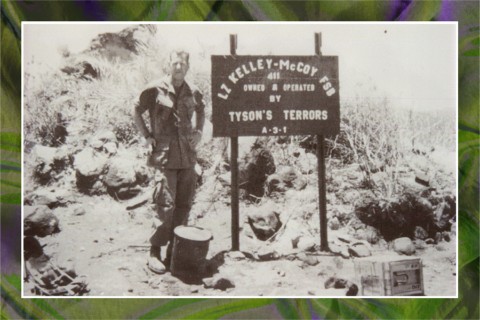
Photograph Provided by Bob Tyson
In July of 1969, Lieutenant Colonel (LTC) George Ellis, commander of the 3rd Battalion, 1st Infantry, 11th Brigade was given the mission to select a site for a firebase in the valley west of Quang Ngai City, South Vietnam. Quang Ngai Valley had been previously occupied at different times by numerous units from the American forces. They eventually left the area after suffering numerous casualties inflicted by units of the North Vietanmese Army (NVA) and the local Viet Cong (VC).
After studying a map of the Quang Ngai Valley and making several aerial observations, LTC Ellis selected a hill located at grid co-ordinate 77,38 because it would afford its future occupants with the most protection from the enemy. The hill was approximately 156 feet above sea level and provided a commanding view of the Quang Ngai Valley. Rice paddies that surrounded the hill had been farmed by the local peasants and their ancestors for hundreds of years. About four kilometers to the north, the Song Tra Khuc River ran from west to east. To the west, the mountains were about 3 kilometers away. A rocky ridge at the base of the mountains was later named "Pepper Ridge" by the soldiers, because from a distance it looked like pepper had been sprinkled over the huge rocks. The site of the proposed firebase was also about 12 miles southwest of the infamous My Lai village.
LTC Ellis reported back to Colonel Treadwell, commander of the 11th Brigade, his findings and site recommendation. Colonel Treadwell then gave the mission of building the firebase to LTC Ellis.
Originally, the grunts from Alpha Company wanted to name the firebase after SGTs Kelley and McCoy, who were killed in separate incidents just prior to the mission to establish the firebase, but that was not to be. Instead, it was named after the 4th ARVN Regiment and the 11th LIB and called FSB 4-11.

Captain Bob Tyson (pictured above), commander of Company A, 3rd Battalion, 1st Infantry, 11th Brigade, was given the responsibility of securing the hill where the firebase was to be built. On July 8th, Company A was airlifted by helicopters to an area near the site of the new firebase. Moving across the hill, the men of Company A found many booby traps. Second Lieutenant John F. Baxter, first platoon leader, said, "My men had to watch every step they made. It seemed as if there was a booby trap under every bush." To clear the hill of booby traps, a mine sweeping device, frequently used by combat engineers, was deployed. Using this device, the soldiers found booby-trapped grenades, 2.75 inch rockets, and a cannister full of napalm that was connected to a firing device hidden in the ground.
After the hill was secured and a temporary chopper pad was constructed, the combat engineers came in to begin the construction of the firebase. The men of Company A contributed a lot of muscle and sweat to the construction of the firebase. At the same time, they provided protection and security for the combat engineers. A tank battalion from the 4th ARVN Regiment was also assigned to help provide perimeter defense for the new firebase. During the daytime, the South Vietnamese performed well but at night they could not be depended upon when it came to security.
The firebase was originally built to be held by one infantry company from the 11th Brigade and the tank battalion from the 4th ARVN Regiment. Shortly after the firebase construction began, the tank battalion was reassigend to a new area. Because of this, other elements from the 3rd Battalion, 1st Infantry were redeployed to Fire Support Base 4-11.
From the very beginning of the operation to build the new firebase and to establish a new area of operations (AO), the men of the 3rd Battalion, 1st Infantry were at a great disadvantage. Quang Ngai Valley had been a Viet Cong stronghold for many years. The average age of the VC was 35 years, and many of them lived among the local peasants. These VC were very skillful in the art of making booby traps out of unexploded American ordnance (duds) and bamboo. Also, some of the VC were expert snipers who knew the terrain very well. They had rifles hidden in various locations in the area that they operated out of. During the daylight, some of the snipers were disguised as farmers. Upon seeing a group of Americans soldiers across open terrain, a VC sniper could quickly locate a hidden rifle, fire off a few rounds, and quickly disappear. Thus, booby traps and VC snipers in the area surrounding Fire Support Base 4-11 were the biggest enemies of the men from the 3rd Battalion, 1st Infantry.
Source: Stars and Stripes, military documents, and personal account of Lieutenant Colonel George Ellis, commander of the 3rd Battalion, 1st Infantry during 1969.
Notice: You can purchase a copy of the Hill 411 Association, Americal Division book written by Leslie Stottle, Colonel, US Army Retired, former Commander of the 3rd Battalion, 1st Infantry. Les and his wife Mickey researched military records to document an overview of the day-by-day events that occurred on and around FSB 4-11 from July 1969 through October of 1971. For your copy of this book, please make a check for $17.50 payable to the "Hill 4-11 Association" and send it with your request to the Treasurer of the Hill 4-11 Association as follows:
Richard E. Hill
630 Woodside Dr.
Kent, OH 44240
